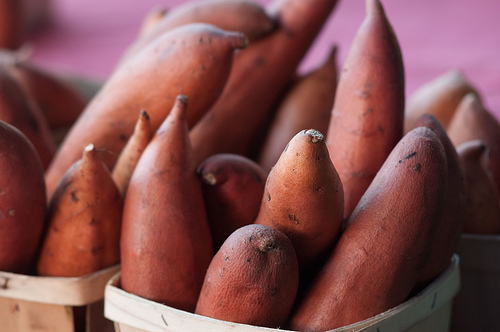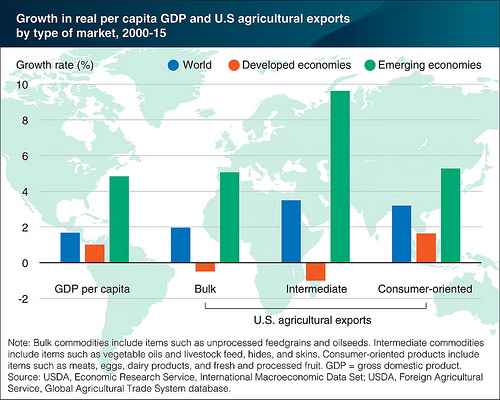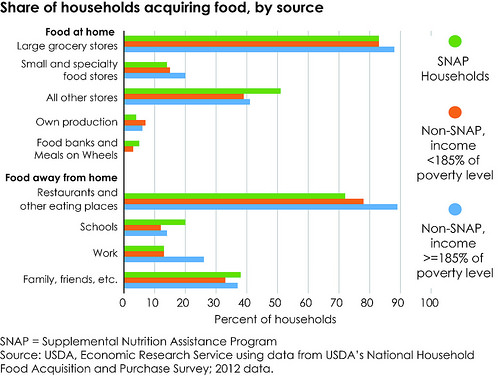
Since 2000, per capita consumption has risen as consumers increasingly enjoy sweet potatoes beyond the holiday table.
Chances are that if you order a side of fries at a restaurant, you need to specify whether you’re asking for white potatoes or sweet potatoes. Food trends that support the consumption of more healthful, colorful and unique foods have helped to encourage sales of sweet potatoes in the form of fries, chips, ready-to-cook and heat-and-eat preparations, expanding consumption of the orange tuber well beyond the holiday table.
Domestic consumption of sweet potatoes has grown considerably since 2000 with annual per capita availability (a proxy for consumption) rising from 4.2 pounds to reach a record-high 7.5 pounds in 2015. The marked rise in domestic demand has been encouraged by promotion of the health benefits of sweet potatoes – rich in vitamins A and C, high in fiber. Expanded demand has also been supported by the increasing variety of sweet potato products available in restaurants and for home preparation. Read more »

This is the top “Editors’ Pick” among the Charts of Note – an USDA Economic Research Service series. ERS editors selected the 10 best from 244 graphs and maps posted in 2016. Charts are provided daily on the web–and via email by free subscription.
Pictures may be worth a thousand words, but they can also help put numbers into a clearer perspective.
That‘s why USDA’s Economic Research Service (ERS) each day presents a graph or map with brief accompanying text that tells a visual mini-story about food, farming or rural America. Delivered to PCs, smartphones and tablets via email as well as being posted on our website, these “Charts of Note” provide daily snapshots of ERS research and findings. They cover facts and data that are timely, informative and sometimes surprising. Read more »

FoodAPS data show the sources of food acquisitions (e.g., store types, restaurants, and schools) by SNAP households and by non-SNAP households of differing income levels.
USDA’s Economic Research Service (ERS) has developed a unique treasure trove of data from a survey on food purchases and acquisitions by U.S. households – USDA’s National Household Food Acquisition and Purchase Survey FoodAPS. To protect individual survey respondents’ privacy, access to the data had been restricted to researchers from academic institutions and government agencies. Now, a modified version that aggregates information so individuals cannot be identified, but still provides valuable data for research and planning is available to everyone.
What can FoodAPS data tell us? USDA’s investment in FoodAPS was undertaken to fill a critical knowledge gap and encourage research that can support an evidence-based approach to Federal food assistance policies and programs. The data are being used to address a range of questions such as where households acquire food in a typical week, which foods they acquire, how much they pay for the food and how the acquired foods match recommendations for a healthy diet. Read more »

Each day, nearly 1,300 veterans and their family members return to civilian life. USDA is helping many veterans transition from the military to agriculture.
In honor of Veterans Day, Deputy Under Secretary Lanon Baccam provided Agriculture Secretary Tom Vilsack with an overview of USDA’s support for veterans. Baccam, a proud army veteran, also serves as the Department’s Military Veterans Agriculture Liaison. Read more »
Tags: AgrAbility, AMS, Arkansas, ARS, Department of Defense, Department of Labor, Department of Veterans Affairs, ERS, FSA, Lanon Baccam, NIFA, NRCS, Tom Vilsack, veterans, Veterans Affairs, Veterans Day, West Virginia
 Education, Environment, Science
Education, Environment, Science

USDA’s National Agricultural Statistics Service will hold its annual Data Users’ Meeting, followed by a live Twitter #StatChat at 6 p.m. ET on Tuesday, October 18.
As I’ve learned over my years with the National Agricultural Statistics Service (NASS), in order to make an impact, our information needs to meet the needs of the people who use the data we produce. And while we constantly try to gauge and meet their needs, it is imperative to speak to our data users directly to get their input. We are open to feedback all the time and we hold annual special Data Users’ Meeting in Chicago every October.
Of course face-to-face interaction has its limitations since not everyone can travel to Chicago to meet with us. To address this concern, for the first time this year, we are also adding a social media component to our Data Users’ Meeting. Immediately following the panel session at the meeting, from 5 p.m. to 5:30 p.m. Central Time, I will be answering questions via Twitter during our monthly #StatChat. Read more »
Tags: #StatChat, Data, ERS, FAS, FSA, Honeybees, Illinois, NASS, pollination, social media, statistics, surveys, U.S. Census Bureau, WAOB
 International, Technology and Broadband, Trade
International, Technology and Broadband, Trade

Many NIFA-funded programs make it easier for low income families to access fresh, nutritious foods and stretch their food-buying dollars. (iStock image)
The National Institute of Food and Agriculture (NIFA) opened its doors on Oct. 1, 2009, created by the 2008 Farm Bill. NIFA begins its eighth year as USDA’s premier extramural agricultural science agency by examining its role in helping reduce hunger in the United States.
As a nation, we are making great strides in combating food insecurity—the limited access to adequate food due to a lack of money and other resources. A recent household food security report issued by USDA’s Economic Research Service (ERS) shows the lowest figures on record for food insecurity among children.
Funding and leadership from USDA’s National Institute of Food and Agriculture (NIFA) support many food and nutrition assistance programs that provide low-income households access to food, a healthful diet and nutrition education. Three such programs are the Food Insecurity Nutrition Incentive (FINI), Community Food Projects (CFP), and the Expanded Food and Nutrition Education Program (EFNEP). Read more »
Tags: children, Community Food Projects, EFNEP, ERS, Expanded Food and Nutrition Education Program, Farm Bill, FINI, Food and Nutrition, Food Farm and Jobs Bill, food insecurity, Food Insecurity Nutrition Incentive, Food Security, Hunger, Mississippi, NIFA, Nutrition, Nutrition Assistance, SNAP, Supplemental Nutrition Assistance Program
 Food and Nutrition, Food Security
Food and Nutrition, Food Security






